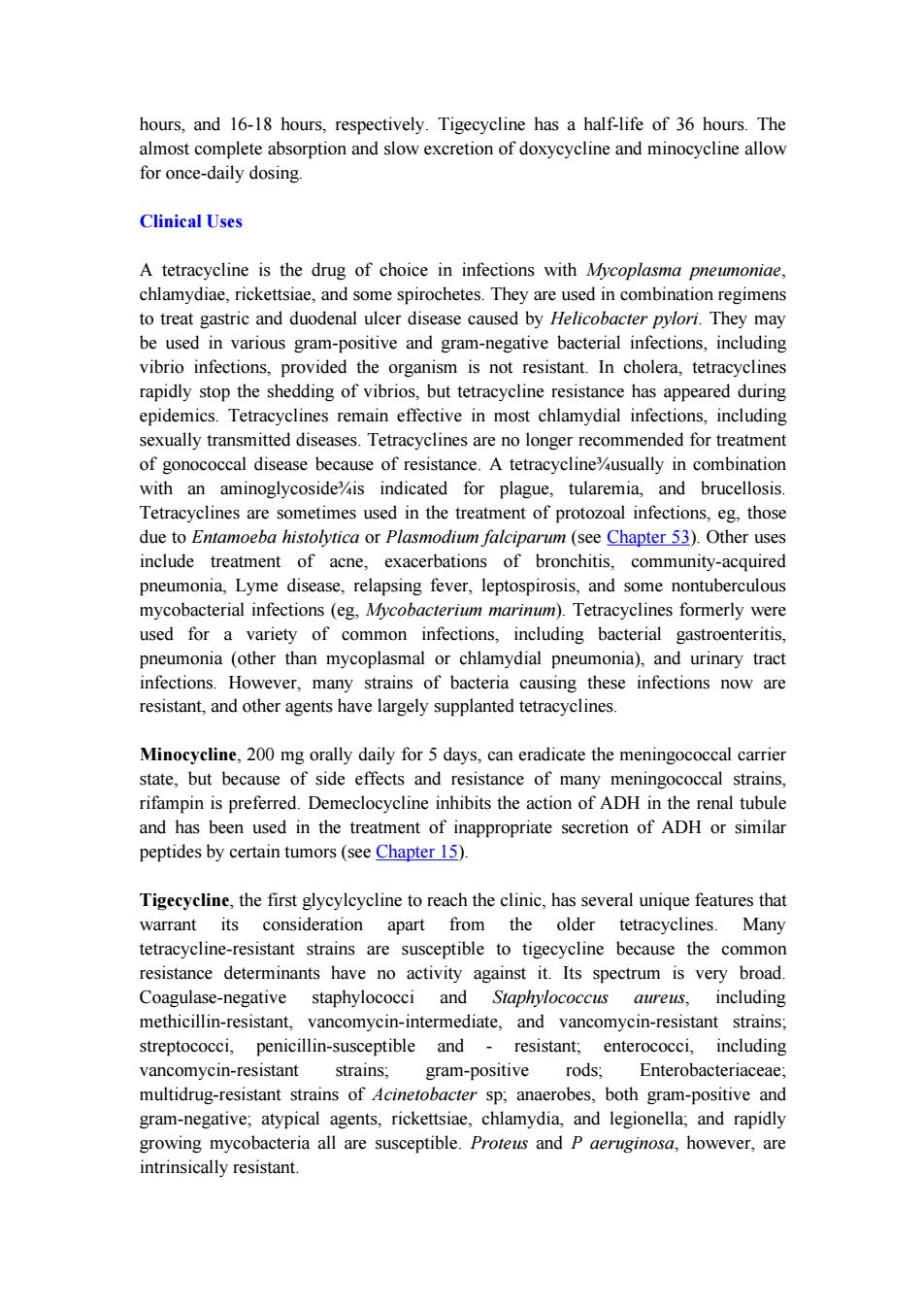正在加载图片...

hours,and 16-18 hours,respectively.Tigecycline has a half-life of 36 hours.The almost complete absorption and slow excretion of doxycycline and minocycline allow for once-daily dosing. Clinical Uses A tetracycline is the drug of choice in infections with Mycoplasma pneumoniae, chlamydiae,rickettsiae,and some spirochetes.They are used in combination regimens to treat gastric and duodenal ulcer disease caused by Helicobacter pylori.They may be used in various gram-positive and gram-negative bacterial infections,including vibrio infections,provided the organism is not resistant.In cholera,tetracyclines rapidly stop the shedding of vibrios,but tetracycline resistance has appeared during epidemics.Tetracyclines remain effective in most chlamydial infections,including sexually transmitted diseases.Tetracyclines are no longer recommended for treatment of gonococcal disease because of resistance.A tetracycline%usually in combination with an aminoglycosideis indicated for plague,tularemia,and brucellosis. Tetracyclines are sometimes used in the treatment of protozoal infections,eg,those due to Entamoeba histolytica or Plasmodium falciparum (see Chapter 53).Other uses include treatment of acne,exacerbations of bronchitis,community-acquired pneumonia,Lyme disease,relapsing fever,leptospirosis,and some nontuberculous mycobacterial infections(eg,Mycobacterium marinum).Tetracyclines formerly were used for a variety of common infections,including bacterial gastroenteritis, pneumonia (other than mycoplasmal or chlamydial pneumonia),and urinary tract infections.However,many strains of bacteria causing these infections now are resistant,and other agents have largely supplanted tetracyclines. Minocycline,200 mg orally daily for 5 days,can eradicate the meningococcal carrier state,but because of side effects and resistance of many meningococcal strains, rifampin is preferred.Demeclocycline inhibits the action of ADH in the renal tubule and has been used in the treatment of inappropriate secretion of ADH or similar peptides by certain tumors(see Chapter 15). Tigecycline,the first glycylcycline to reach the clinic,has several unique features that warrant its consideration apart from the older tetracyclines.Many tetracycline-resistant strains are susceptible to tigecycline because the common resistance determinants have no activity against it.Its spectrum is very broad. Coagulase-negative staphylococci and Staphylococcus aureus,including methicillin-resistant,vancomycin-intermediate,and vancomycin-resistant strains; streptococci,penicillin-susceptible and-resistant;enterococci,including vancomycin-resistant strains;gram-positive rods;Enterobacteriaceae; multidrug-resistant strains of Acinetobacter sp;anaerobes,both gram-positive and gram-negative;atypical agents,rickettsiae,chlamydia,and legionella;and rapidly growing mycobacteria all are susceptible.Proteus and P aeruginosa,however,are intrinsically resistant.hours, and 16-18 hours, respectively. Tigecycline has a half-life of 36 hours. The almost complete absorption and slow excretion of doxycycline and minocycline allow for once-daily dosing. Clinical Uses A tetracycline is the drug of choice in infections with Mycoplasma pneumoniae, chlamydiae, rickettsiae, and some spirochetes. They are used in combination regimens to treat gastric and duodenal ulcer disease caused by Helicobacter pylori. They may be used in various gram-positive and gram-negative bacterial infections, including vibrio infections, provided the organism is not resistant. In cholera, tetracyclines rapidly stop the shedding of vibrios, but tetracycline resistance has appeared during epidemics. Tetracyclines remain effective in most chlamydial infections, including sexually transmitted diseases. Tetracyclines are no longer recommended for treatment of gonococcal disease because of resistance. A tetracycline¾usually in combination with an aminoglycoside¾is indicated for plague, tularemia, and brucellosis. Tetracyclines are sometimes used in the treatment of protozoal infections, eg, those due to Entamoeba histolytica or Plasmodium falciparum (see Chapter 53). Other uses include treatment of acne, exacerbations of bronchitis, community-acquired pneumonia, Lyme disease, relapsing fever, leptospirosis, and some nontuberculous mycobacterial infections (eg, Mycobacterium marinum). Tetracyclines formerly were used for a variety of common infections, including bacterial gastroenteritis, pneumonia (other than mycoplasmal or chlamydial pneumonia), and urinary tract infections. However, many strains of bacteria causing these infections now are resistant, and other agents have largely supplanted tetracyclines. Minocycline, 200 mg orally daily for 5 days, can eradicate the meningococcal carrier state, but because of side effects and resistance of many meningococcal strains, rifampin is preferred. Demeclocycline inhibits the action of ADH in the renal tubule and has been used in the treatment of inappropriate secretion of ADH or similar peptides by certain tumors (see Chapter 15). Tigecycline, the first glycylcycline to reach the clinic, has several unique features that warrant its consideration apart from the older tetracyclines. Many tetracycline-resistant strains are susceptible to tigecycline because the common resistance determinants have no activity against it. Its spectrum is very broad. Coagulase-negative staphylococci and Staphylococcus aureus, including methicillin-resistant, vancomycin-intermediate, and vancomycin-resistant strains; streptococci, penicillin-susceptible and - resistant; enterococci, including vancomycin-resistant strains; gram-positive rods; Enterobacteriaceae; multidrug-resistant strains of Acinetobacter sp; anaerobes, both gram-positive and gram-negative; atypical agents, rickettsiae, chlamydia, and legionella; and rapidly growing mycobacteria all are susceptible. Proteus and P aeruginosa, however, are intrinsically resistant